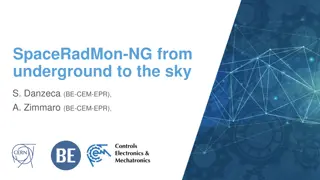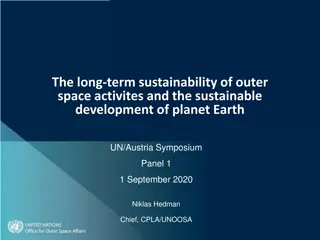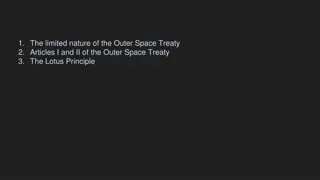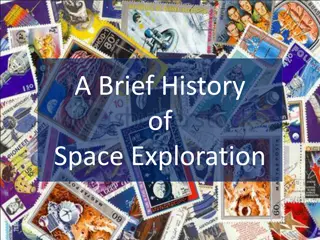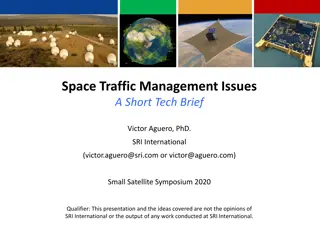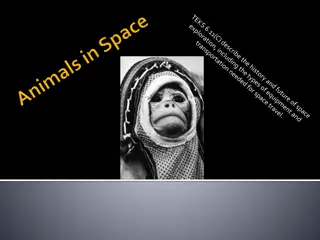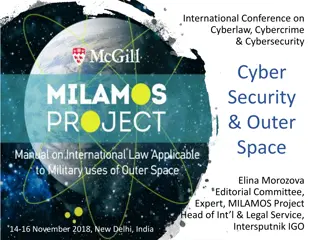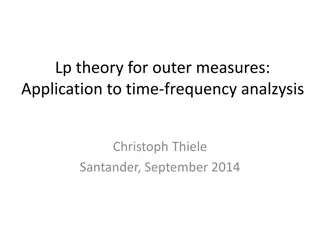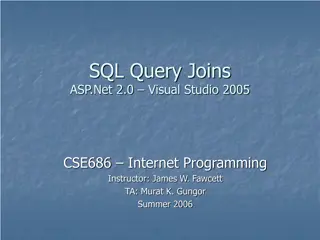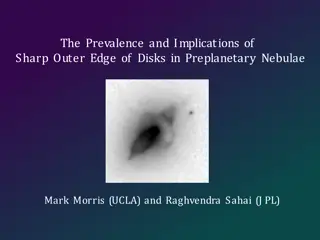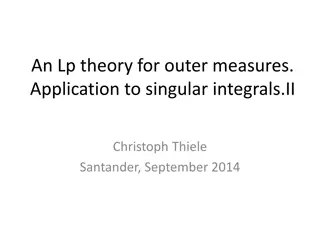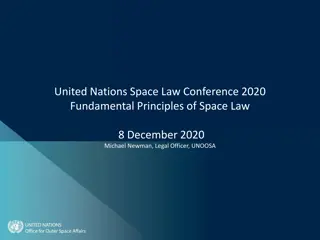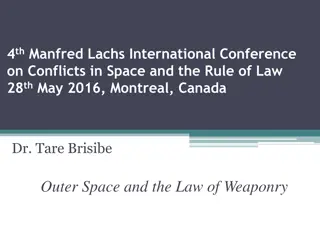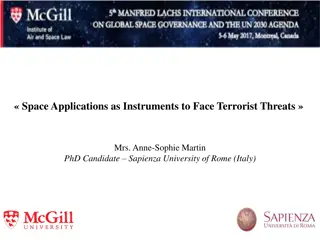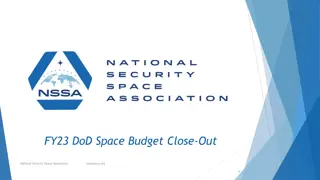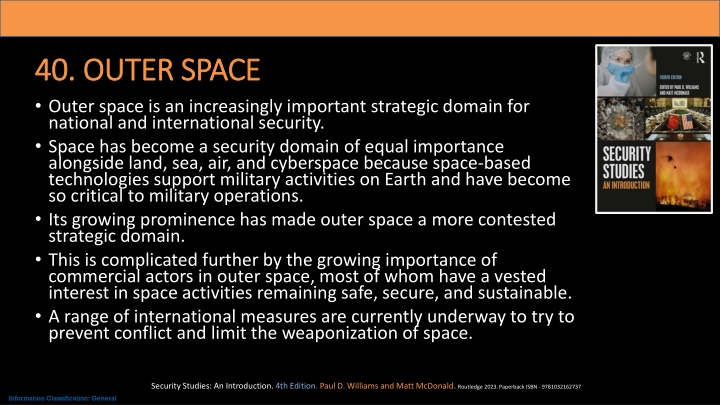
Importance of Space Security in Modern Warfare
Explore the evolving significance of outer space in military operations, the growing role of commercial entities, and the intricate dynamics of space security. Learn about the criticality of space systems and the Outer Space Treaty of 1967.
Download Presentation

Please find below an Image/Link to download the presentation.
The content on the website is provided AS IS for your information and personal use only. It may not be sold, licensed, or shared on other websites without obtaining consent from the author. If you encounter any issues during the download, it is possible that the publisher has removed the file from their server.
You are allowed to download the files provided on this website for personal or commercial use, subject to the condition that they are used lawfully. All files are the property of their respective owners.
The content on the website is provided AS IS for your information and personal use only. It may not be sold, licensed, or shared on other websites without obtaining consent from the author.
E N D
Presentation Transcript
40. OUTER SPACE 40. OUTER SPACE Outer space is an increasingly important strategic domain for national and international security. Space has become a security domain of equal importance alongside land, sea, air, and cyberspace because space-based technologies support military activities on Earth and have become so critical to military operations. Its growing prominence has made outer space a more contested strategic domain. This is complicated further by the growing importance of commercial actors in outer space, most of whom have a vested interest in space activities remaining safe, secure, and sustainable. A range of international measures are currently underway to try to prevent conflict and limit the weaponization of space. Security Studies: An Introduction. 4th Edition. Paul D. Williams and Matt McDonald. Routledge 2023. Paperback ISBN - 9781032162737 Information Classification: General
WHY SPACE MATTERS WHY SPACE MATTERS Though most of us don t think about outer space as part of our daily lives, our current activities and habits are dependent on space-based services e.g., GPS in phones, satellite data for financial transactions, internet access etc. Militaries are also highly dependent on space-based services for navigation; telecommunications; tracking the movement of troops and refugees in war; identifying evidence of war crimes; drone operations; GPS-guided weapons; and cyberwarfare. Increasing dependence on space technologies has meant that space has itself become a contested strategic domain: during peacetime, grey zone, or actual war. In a much-quoted phrase, space is described as congested, contested and competitive : It is congested, because of the sheer number of satellites orbiting the Earth. It is contested, because of how militarily important and therefore vulnerable space systems have become. It is competitive because the space sector is worth billions globally, and commercial actors have disrupted the economic and technological assumptions in this sector. But it is also cooperative, and space security can benefit from increased collaboration and communication. Security Studies: An Introduction. 4th Edition. Paul D. Williams and Matt McDonald. Routledge 2023. Paperback ISBN - 9781032162737 Information Classification: General
UNDERSTANDING SPACE SYSTEMS UNDERSTANDING SPACE SYSTEMS It s useful to think of space systems as having three segments: 1. the space-based segment, such as satellites or spacecraft; 2. the ground segment, where ground stations receive data or communications from the satellites (think of a satellite dish, your smartphone, or large infrastructure to receive and consolidate data); 3. the link between the space and ground segments; the signal that sends the data from space to Earth, or communicates flight or other information to the satellite from Earth. This is usually radio frequencies, but increasingly there are alternatives being developed such as optical, laser and quantum communications. To this traditional picture, we can add a fourth segment: 4. Humans. We use satellite data and applications, and are dependent on space systems remaining operational. Humans are also necessary to operate satellites in space and to interpret and apply the data received. Security Studies: An Introduction. 4th Edition. Paul D. Williams and Matt McDonald. Routledge 2023. Paperback ISBN - 9781032162737 Information Classification: General
THE OUTER SPACE TREATY (1967) THE OUTER SPACE TREATY (1967) The 1967 Outer Space Treaty promises in Article I that space shall be the province of all mankind . Core principles of the Treaty are: The prohibition of national appropriation or claims of sovereignty in space. The application of international law to space, with specific reference to the UN Charter, including the prohibition on the use of force, and the desire for all activities to be based on international cooperation. The prohibition of the placement of nuclear weapons and military bases in orbit around the Earth or on the Moon or other celestial bodies i.e., all natural bodies such as planets, asteroids, etc. The responsibility of states for all space activities under their jurisdiction, whether by commercial or governmental entities, including their authorization (e.g., licencing) and continued supervision of those activities. Security Studies: An Introduction. 4th Edition. Paul D. Williams and Matt McDonald. Routledge 2023. Paperback ISBN - 9781032162737 Information Classification: General
COOPERATION BEYOND THE OST (1967) COOPERATION BEYOND THE OST (1967) The OST (1967) was followed by four other treaties, which deal with issues such as: Assisting astronauts in distress (Return and Rescue Agreement 1968); State responsibility and liability for damage caused by space activities (Liability Convention 1972); The need to track the already rapid increase in space traffic, including ownership and jurisdiction (Registration Convention 1976); A potential governance regime for future natural resource extraction on the Moon and asteroids (Moon Agreement 1979). This treaty has the lowest participation, with only 18 countries signatories, and none of the major players in space. Aside from these core space treaties, outer space is also subject to many other international law treaties and rules. For the purposes of space security, the most important to highlight are: the rules prohibiting the use of force and limiting self-defence; the laws of armed conflict; various treaties and rules limiting the testing of nuclear weapons and the use of indiscriminate weapons, including those which impact the environment; human rights law; and international environmental law. Security Studies: An Introduction. 4th Edition. Paul D. Williams and Matt McDonald. Routledge 2023. Paperback ISBN - 9781032162737 Information Classification: General
CONGESTED: CROWDED ORBITS CONGESTED: CROWDED ORBITS 50 years after the first satellite was launched in 1957, there were less than 1,000 operational satellites in orbit, the vast majority of which were launched, owned, and operated by governments. Between 2008 and 2021, the number of operational satellites reached nearly 5,000, and the majority of these are now commercially-owned. By 2030, estimates suggest there will be 100,000 operational satellites in orbit. We are very near the tipping point described by Donald Kessler in the 1970s, that the density of space traffic and space debris will lead to debris colliding with debris, creating breakup into even smaller pieces of debris, and an irreversible cascading effect known as the Kessler syndrome, rendering these precious orbits unusable. Although space is very big, the near-Earth orbits which are strategically and commercially most useful are nearly saturated with space traffic and space debris. Security Studies: An Introduction. 4th Edition. Paul D. Williams and Matt McDonald. Routledge 2023. Paperback ISBN - 9781032162737 Information Classification: General
CONTESTED: MILITARIZATION & CONTESTED: MILITARIZATION & WEAPONIZATION WEAPONIZATION When the USSR launched Sputnik in 1957, there were media frenzies in the West speculating whether this was a weapon, or a sophisticated intelligence-gathering technology. In the traditional domains of land, sea, and air, having technological supremacy is an advantage militarily. But those states with a high dependency on space-based technologies are the most vulnerable, because other actors could interrupt, deny, degrade, or destroy any of the segments of a space system, and it can be difficult to attribute a fault or interruption to a specific actor. The strategic importance of space-based technologies means that these systems are being targeted and there is a risk of space becoming a theatre of conflict, but not necessarily a kinetic, explosive battlefield. Recently, the development of anti-satellite weapons (ASATs) by several states is a disruptive development in space security. However, the most likely threats to space systems will come through non-kinetic weapons, such as cyberattacks, for example. Security Studies: An Introduction. 4th Edition. Paul D. Williams and Matt McDonald. Routledge 2023. Paperback ISBN - 9781032162737 Information Classification: General
COMPETITIVE: OLD SPACE, NEW SPACE & COMPETITIVE: OLD SPACE, NEW SPACE & BEYOND BEYOND From the beginning of the space age to the early 2000s, what is now termed Old Space dominated the sector. Space programmes fell entirely under the remit of governments, and geopolitics determined which states had sufficient wealth and access to technology to become a space actor. From the early 2000s, the term NewSpace described a shift in the economics of the sector, especially in the dominant space economies of North America and Europe. Governments began to outsource many of the space technologies they provided, including for military purposes, to commercial entities. The 2010s and 2020s is an era of NewSpace 2.0 where disruptive economic models and disruptive technologies have created both positive and challenging dynamics. In this era, commercial actors have become fundamentally implicated in space security. Currently, we are entering NewSpace 3.0 where there is competition for access to, and technological prowess in, the so-called cis-lunar (between the Earth and the Moon) and lunar economies. Security Studies: An Introduction. 4th Edition. Paul D. Williams and Matt McDonald. Routledge 2023. Paperback ISBN - 9781032162737 Information Classification: General
COOPERATION, COLLABORATION, COOPERATION, COLLABORATION, COMMUNICATION COMMUNICATION The risks of war in or over space can be tempered with sufficient awareness, and a commitment to cooperation, collaboration, and communication. Human space activities have always included these dynamics, even at the height of the Cold War, and there is a lot of work underway in space diplomacy to ensure this continues. Even during periods both of tension and of d tente in the Cold War, there was scientific collaboration between experts in the Soviet and US space programmes. The International Space Station (ISS) is often acknowledged as an example of cooperation that transcends geopolitics, involving a decades long scientific collaboration between Canada, ESA, Japan, Russia, and the United States. There have also been positive shifts internationally on space arms control, with China and Russia co-sponsoring a draft Treaty on Prevention of the Placement of Weapons in Outer Space in 2008 and 2014. Perhaps the greatest threats to stability in space, and to the space environment, are the general lack of transparency and clarity about specific activities in space. Security Studies: An Introduction. 4th Edition. Paul D. Williams and Matt McDonald. Routledge 2023. Paperback ISBN - 9781032162737 Information Classification: General
CONCLUSION CONCLUSION Humanity now relies heavily on outer space, but there remains a lack of sufficient literacy about this domain in the general public and among decisionmakers. Greater public awareness about the safety, security, and sustainability of outer space is required. In a new multipolar era of global politics, we need complex, multilayered thinking and a global approach to the wicked problems facing humanity. Geopolitics will continue to play out in space as in any other domain, which is why equal access to space and the benefits it provides must be among the many priorities for this century, including inter-generational justice. Space, like the rest of our environments, must be protected from further environmental degradation and from the negative impacts of conflict. Security Studies: An Introduction. 4th Edition. Paul D. Williams and Matt McDonald. Routledge 2023. Paperback ISBN - 9781032162737 Information Classification: General
ESSAY / EXAM QUESTIONS ESSAY / EXAM QUESTIONS Is outer space really the province of all mankind ? Should the Outer Space Treaty (1967) be revised? Explain your answer. How vulnerable are space systems, and what are the most pressing threats to them? In what ways does the commercialization of space challenge security? What are the main differences between Old Space and NewSpace and have they made a safe, secure and sustainable domain more or less likely? Will outer space always be militarized? How can the weaponization of outer space best be managed? Will the increase in counter-space capabilities create a security dilemma in space? Explain your answer using examples. To what extent can conflict between states over outer space be prevented through communication, collaboration and cooperation? Security Studies: An Introduction. 4th Edition. Paul D. Williams and Matt McDonald. Routledge 2023. Paperback ISBN - 9781032162737 Information Classification: General
WEBSITES AND AUDIO WEBSITES AND AUDIO- -VISUAL RESOURCES VISUAL RESOURCES Websites Films and Television United Nations Office for Outer Space Affairs and European Space Agency space debris infographics and podcasts: https://www.unoosa.org/oosa/en/informationfor/media/unoosa- and-esa-release-infographics-and-podcasts-about-space-debris.html Return to Space (2022) https://www.youtube.com/watch?v=sIME4sLR4-8 The Expanse (2016-2022) https://expanse.fandom.com/wiki/The_Expanse_(TV) Proxima (2019) https://www.youtube.com/watch?v=WZMJJZVyODc Space Generation Advisory Council https://spacegeneration.org/ Mars (2016) www.nationalgeographic.com/tv/mars/ Space News https://spacenews.com/ Hidden Figures (2016) https://www.youtube.com/watch?v=o590IXDDdB4 SPACE Act: https://www.congress.gov/bill/114th-congress/house- bill/2262 The Martian (2015) https://www.youtube.com/watch?v=ej3ioOneTy8 Australia s First Astronomers(2009 Australian Broadcasting Corporation) http://www.abc.net.au/science/articles/2009/07/27/2632463.htm Moon (2009) https://www.youtube.com/watch?v=twuScTcDP_Q Gravity (2013) https://www.youtube.com/watch?v=OiTiKOy59o4 A Day Without Space: https://www.youtube.com/watch?v=lLRdNEQqxAg Apollo 13 (1995) https://www.youtube.com/watch?v=KtEIMC58sZo Aerospace Center for Space Policy and Strategy, Space Policy Show https://csps.aerospace.org/space-policy-show Security Studies: An Introduction. 4th Edition. Paul D. Williams and Matt McDonald. Routledge 2023. Paperback ISBN - 9781032162737 Information Classification: General

![Read⚡ebook✔[PDF] Linking the Space Shuttle and Space Stations: Early Docking Te](/thumb/21519/read-ebook-pdf-linking-the-space-shuttle-and-space-stations-early-docking-te.jpg)

